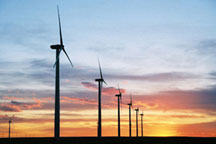____________________________________________________________________
Windpower technology dates back many centuries. There are historical claims
that wind machines which harness the power of the wind date back beyond the time
of the ancient Egyptians. Hero of Alexandria used a simple windmill to power an
organ whilst the Babylonian emperor, Hammurabi, used windmills for an ambitious
irrigation project as early as the 17th century BC. The Persians built windmills
in the 7th century AD for milling and irrigation and rustic mills similar to
these early vertical axis designs can still be found in the region today. In
Europe the first windmills were seen much later, probably having been introduced
by the English on their return from the crusades in the middle east or possibly
transferred to Southern Europe by the Muslims after their conquest of the
Iberian Peninsula. It was in Europe that much of the subsequent technical
development took place. By the late part of the 13th century the typical
'European windmill' had been developed and this became the norm until further
developments were introduced during the 18th century. At the end of the 19th
century there were more than 30,000 windmills in Europe, used primarily for the
milling of grain and water pumping.
Modern wind generators
The first wind powered electricity was produced by a machine built by Charles
F. Brush in Cleveland, Ohio in 1888. It had a rated power of 12 kW (direct
current - dc). Direct current electricity production continued in the form of
small-scale, stand-alone (not connected to a grid) systems until the 1930's when
the first large scale AC turbine was constructed in the USA. There was then a
general lull in interest until the 1970's when the fuel crises sparked a revival
in research and development work in North America (USA and Canada) and Europe
(Denmark, Germany, The Netherlands, Spain, Sweden and the UK). Modern wind
turbine generators are highly sophisticated machines, taking full advantage of
state-ofthe- art technology, led by improvements in aerodynamic and structural
design, materials technology and mechanical, electrical and control engineering
and capable of producing several megawatts of electricity. During the 1980's
installed capacity costs dropped considerably and windpower has become an
economically attractive option for commercial electricity generation. Large wind
farms or wind power stations have become a common sight in many western
countries. In 2001 Denmark alone had 2000 Megawatts of electricity generating
capacity from more than 5,700 wind turbines, representing 14% of their national
electricity consumption (Source: www.windpower.dk). Wind is a clean, safe,
renewable form of energy.

To a lesser degree, there has been a parallel development in small-scale wind
generators for supplying electricity for battery charging, for stand-alone
applications and for connection to small grids.